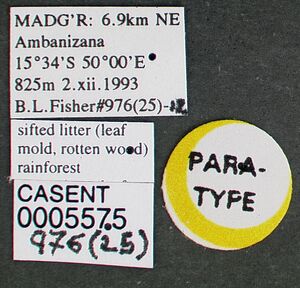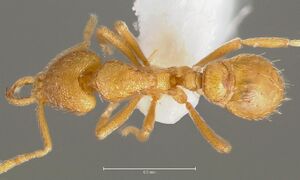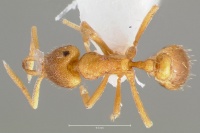Strumigenys lexex
| Strumigenys lexex | |
|---|---|

| |
| Scientific classification | |
| Kingdom: | Animalia |
| Phylum: | Arthropoda |
| Class: | Insecta |
| Order: | Hymenoptera |
| Family: | Formicidae |
| Subfamily: | Myrmicinae |
| Tribe: | Attini |
| Genus: | Strumigenys |
| Species: | S. lexex |
| Binomial name | |
| Strumigenys lexex Fisher, 2000 | |
Known mostly from rainforest litter-sample collections.
Identification
Bolton (2000) - A member of the scotti complex in the Strumigenys scotti-group. S. lexex and Strumigenys livens are distinguished from other members of the scotti-complex by having: pronotum without erect hairs except for flagellate humeral hairs, mesonotum with 2 or 3 pairs of erect hairs, and the ventral spongiform tissue of petiolar peduncle in profile an irregular, narrow strip along the base of the peduncle.
S. lexex is distinguished from livens and from other members of the scotti-complex by the presence of appressed fine hairs on the lateral margins of first gastral tergite. In addition, the postpetiole has numerous hairs of variable length in lexex while livens has three pairs of erects hairs of similar length. See also under Strumigenys glycon for further discussion.
Keys including this Species
Distribution
Latitudinal Distribution Pattern
Latitudinal Range: -15.56667° to -15.56667°.
| North Temperate |
North Subtropical |
Tropical | South Subtropical |
South Temperate |
- Source: AntMaps
Distribution based on Regional Taxon Lists
Afrotropical Region: Uganda.
Malagasy Region: Madagascar (type locality).
Distribution based on AntMaps
Distribution based on AntWeb specimens
Check data from AntWeb
Countries Occupied
| Number of countries occupied by this species based on AntWiki Regional Taxon Lists. In general, fewer countries occupied indicates a narrower range, while more countries indicates a more widespread species. |

|
Estimated Abundance
| Relative abundance based on number of AntMaps records per species (this species within the purple bar). Fewer records (to the left) indicates a less abundant/encountered species while more records (to the right) indicates more abundant/encountered species. |

|
Biology
|
Castes
Worker
Images from AntWeb
   
| |
| Paratype of Strumigenys lexex. Worker. Specimen code casent0005574. Photographer April Nobile, uploaded by California Academy of Sciences. | Owned by CAS, San Francisco, CA, USA. |
   
| |
| Paratype of Strumigenys lexex. Worker. Specimen code casent0005575. Photographer April Nobile, uploaded by California Academy of Sciences. | Owned by MCZ, Cambridge, MA, USA. |
   
| |
| Holotype of Strumigenys lexex. Worker. Specimen code casent0005576. Photographer April Nobile, uploaded by California Academy of Sciences. | Owned by MCZ, Cambridge, MA, USA. |
Nomenclature
The following information is derived from Barry Bolton's Online Catalogue of the Ants of the World.
- lexex. Strumigenys lexex Fisher, in Bolton, 2000: 687 (w.) MADAGASCAR.
Unless otherwise noted the text for the remainder of this section is reported from the publication that includes the original description.
Description
Worker
Holotype. TL 2.1, HL 0.47, HW 0.34, CI 73, ML 0.25, MI 53, SL 0.31, SI 89, PW 0.24, AL 0.51. Characters of scotti-complex. Mandibles short and in full-face view bowed outwards, outer margins evenly convex and width greatest at midlength. Upper scrobe margin shallowly concave immediately behind the frontal lobe; posteriorly evenly and shallowly convex in full-face view, not bordered by a rim or flange, the eyes visible. Maximum diameter of eye approximately equal to maximum width of scape, with 3-4 ommatidia in longest row. Scape subcylindrical, curved and narrowed near the base; hairs on leading edge appressed, fine filiform. Cephalic dorsum densely clothed with curved narrow filiform ground-pilosity that is longer and more conspicuous than hairs on leading edge of scape. Upper scrobe margin fringed with hairs which are similar in shape and size as those on the dorsum. Cephalic dorsum with 6 standing narrow filiform hairs arranged in a transverse row of 4 close to the occipital margin and a more anteriorly situated pair. Pronotal humeral hair flagellate. Mesonotum with a pair of standing narrow remiform hairs on anterior margin and a shorter more posteriorly situated pair of erect filiform hairs (some paratypes with 2 posterior pairs). Propodeum with one pair of short, fine, posteriorly curved hairs immediately anterior of propodeal spines. Dorsal promesonotum with ground pilosity that is similar in size and shape as on cephalic dorsum. Dorsum of alitrunk in outline convex anteriorly and posteriorly gently sloping to the declivity. Metanotal groove shallowly impressed. Anterior mesonotum with a thin carina above the mesothoracic spiracle; mesopleural gland set in a small circular notch. Propodeal tooth triangular, pointed apically and subtended by an inconspicuous, very narrow lamella. Promesonotal dorsum rugulose to reticulate-punctate. Propodeal dorsum superficially areolate. Sides of pronotum punctuate to faintly punctulate. Pleurae and sides of propodeum glassy smooth, punctate peripherally. Postpetiole disc with faint fine punctulate sculpture. In profile ventral spongiform tissue of petiolar peduncle an irregular, narrow strip along base of the peduncle, its deepest point less than maximum width of eye. Ventral spongiform tissue of postpetiole moderately developed. Basigastral costulae long and sharply defined, radiating on each side of a broad central clear area. Dorsal surface of petiole, postpetiole and gaster with numerous standing filiform hairs which are slightly thickened apically. Lateral margins of first gastral tergite with appressed fine hairs. Colour light brown.
Paratypes. TL 1.9-2.1, HL 0.44-0.48, HW 0.34-0.36, CI 73-81, ML 0.25-0.27, MI 53-58, SL 0.29-0.31, SI 81-90, PW 0.22-0.25, AL 0.48-0.51 (7 measured). As holotype.
Measurements of the non-paratypic specimen slightly extend the range of the types-series, HW 0.33, CI 72, hut otherwise match the types in all diagnostic characters.
Type Material
Holotype worker, Madagascar: 6.9 km. NE Amhanizana, 15°34'S, 50°00'E, 825 m., 2.xii.1993, sifted litter (leaf mold, rotten wood), rainforest, 11976 (15)-11 (B. L. Fisher) (Museum of Comparative Zoology).
Paratypes. 1 worker with same data as holotype; 6 workers with same data as holotype but coded (10)-9, (21)-14, (25)-12, (31)-12 (The Natural History Museum, South African Museum).
References
- Fisher, B.L. 2000. The Malagasy fauna of Strumigenys. Pp. 612-696 in: Bolton, B. 2000. The ant tribe Dacetini. Memoirs of the American Entomological Institute. 65:1-1028. (page 687, worker described)
References based on Global Ant Biodiversity Informatics
- Bolton, B. 2000. The Ant Tribe Dacetini. Memoirs of the American Entomological Institute 65
- Fisher B. L. 2003. Formicidae, ants. Pp. 811-819 in: Goodman, S. M.; Benstead, J. P. (eds.) 2003. The natural history of Madagascar. Chicago: University of Chicago Press, xxi + 1709 pp.

